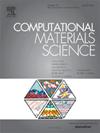了解氢捕获对位错-纳米沉淀相互作用的影响:分子动力学研究
IF 3.3
3区 材料科学
Q2 MATERIALS SCIENCE, MULTIDISCIPLINARY
引用次数: 0
摘要
一个基于分子动力学的建模框架被调用来理解捕获氢对位错沉淀相互作用的影响。在铜(Cu)析出物-铁(Fe)基体界面处捕获的氢增加了位错运动的临界分解剪应力(CRSS)。位错跨析出相移动的CRSS取决于界面性质、析出相尺寸、位错线长度和氢浓度。对于析出相较大、位错较短、析出相-基体界面不一致、含氢较多的材料,位错运动的CRSS一般较高。位错在沉淀中移动的机制取决于位错线的长度。对于较短的位错,有一个简单的切割机制过渡到对于较长的位错,位错切割和攀爬的组合。氢捕获量大、析出相-基体界面共格、位错时间短的材料的氢敏感性指数较高。研究表明,Cu可以通过改变与Cu析出相的位错相互作用的动力学来降低钢的氢敏感性。本文章由计算机程序翻译,如有差异,请以英文原文为准。

Understanding the effect of hydrogen trapping on dislocation-nanoprecipitate interactions: A molecular dynamics study
A molecular dynamics-based modeling framework is invoked to understand the influence of trapped hydrogen on dislocation-precipitate interactions. The hydrogen trapped at the copper (Cu) precipitate-iron (Fe) matrix interface increases the critical resolved shear stress (CRSS) for dislocation movement. The CRSS for dislocation movement across precipitates depends on the nature of the interface, precipitate size, dislocation line lengths, and hydrogen concentration. The CRSS for dislocation movements for materials with larger precipitates, shorter dislocations, incoherent precipitate-matrix interfaces, and more hydrogen is generally higher. The mechanism associated with the movement of a dislocation across the precipitate depends on the dislocation line lengths. There is a transition from a simple cutting-through mechanism for shorter dislocations to a combination of dislocation cutting-through and climbing for longer dislocations. The hydrogen sensitivity index is higher for materials with more trapped hydrogen, coherent precipitate-matrix interfaces, and shorter dislocations. This study suggests Cu could reduce steel’s hydrogen susceptibility by altering the dynamics of dislocation interactions with Cu precipitates.
求助全文
通过发布文献求助,成功后即可免费获取论文全文。
去求助
来源期刊

Computational Materials Science
工程技术-材料科学:综合
CiteScore
6.50
自引率
6.10%
发文量
665
审稿时长
26 days
期刊介绍:
The goal of Computational Materials Science is to report on results that provide new or unique insights into, or significantly expand our understanding of, the properties of materials or phenomena associated with their design, synthesis, processing, characterization, and utilization. To be relevant to the journal, the results should be applied or applicable to specific material systems that are discussed within the submission.
 求助内容:
求助内容: 应助结果提醒方式:
应助结果提醒方式:


